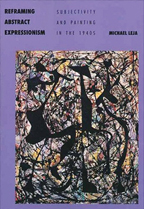 |
Michael Leja. Reframing Abstract Expressionism: Subjectivity and Painting in the 1940s. New Haven: Yale University Press, 1993.
The competition for my third selection was fierce: Michael Baxandall, Painting and Experience in Fifteenth-Century Italy; Martin Jay, Downcast Eyes; Svetlana Alpers, The Art of Describing; Robert Morris, “Notes on Sculpture”; Miwon Kwon, One Place After Another; Saskia Sassen, The Global City; Gerardo Mosquera (ed.), Beyond the Fantastic: Contemporary Art Criticism from Latin America; DeLanda’s A Thousand Years of Nonlinear History …But the prize goes to Michael Leja. Along with the book that serves as its methodological uncle—Serge Guilbaut’s How New York Stole the Idea of Modern Art—this profound study had the effect of cementing my belief in the visual/material-culture approach to the interpretation of art. In retrospect it seems obvious that one should look for insights into Pollock’s conception/depiction of the unconscious, for example, not in Freud but in American film noir and in the dime-store, pseudo-psychological pulp literature of the era. As far as “straight” art history goes, this one’s a standard-bearer.
|